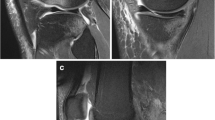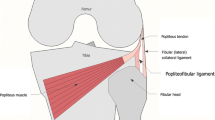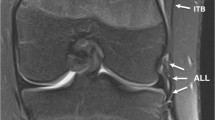Abstract
Objective
To delineate the spectrum of knee injuries associated with sprains and tears of the distal iliotibial band (ITB).
Materials and methods
A retrospective review of 200 random MRI scans undertaken for acute knee trauma was performed. Scans were excluded if there was a history of injury over 4 weeks from the time of the scan, septic arthritis, inflammatory arthropathy, previous knee surgery, or significant artefact. In each scan, the ITB was scored as normal, minor sprain (grade 1), severe sprain (grade 2), and torn (grade 3). The menisci, ligaments, and tendons of each knee were also assessed.
Results
The mean age was 27.4 years (range, 9–69 years) and 71.5 % (n = 143) of the patients were male. The ITB was injured in 115 cases (57.5 %). The next most common soft tissue structure injured was the anterior cruciate ligament (ACL) in 53.5 % of cases (n = 107). Grade 1 ITB injury was seen in 90 of these 115 cases (45 %), grade 2 injury in 20 cases, and grade 3 injury in only five cases. There is a significant association between ITB injury and ACL rupture (p < 0.05), as well as acute patellar dislocation (p < 0.05). There were ten cases of significant posterolateral corner injury, and all were associated with ITB injury, including four ITB tears. Only two cases of isolated ITB injury were seen (1 %).
Conclusions
ITB injury is common in acute knee trauma and is associated with significant internal derangement of the knee, especially cruciate ligament rupture, posterolateral corner injury, and patellar dislocation.





Similar content being viewed by others
References
Bollen S. Epidemiology of knee injuries: diagnosis and triage. Br J Sports Med. 2000;34(3):227–8.
McNally EG. Magnetic resonance imaging of the knee. BMJ. 2002;325(7356):115–6.
Gage BE, McIlvain NM, Collins CL, Fields SK, Comstock RD. Epidemiology of 6.6 million knee injuries presenting to United States emergency departments from 1999 through 2008. Acad Emerg Med Off J Soc Acad Emerg Med. 2012;19(4):378–85.
Flandry F, Hommel G. Normal anatomy and biomechanics of the knee. Sports Med Arthrosc Rev. 2011;19(2):82–92.
Hayes CW, Brigido MK, Jamadar DA, Propeck T. Mechanism-based pattern approach to classification of complex injuries of the knee depicted at MR imaging. Radiograph Rev Publ Radiol Soc N Am, Inc. 2000;20 Spec No: S121–34.
Haims AH, Medvecky MJ, Pavlovich Jr R, Katz LD. MR imaging of the anatomy of and injuries to the lateral and posterolateral aspects of the knee. AJR Am J Roentgenol. 2003;180(3):647–53.
Pacholke DA, Helms CA. MRI of the posterolateral corner injury: a concise review. J Magn Reson Imaging: JMRI. 2007;26(2):250–5.
Seebacher JR, Inglis AE, Marshall JL, Warren RF. The structure of the posterolateral aspect of the knee. J Bone Joint Surg Am Vol. 1982;64(4):536–41.
Beals TC. So who was Gerdy… and how did he get his own tubercle? Am J Orthop (Belle Mead NJ). 1996;25(11):750–2.
Kaplan EB. The iliotibial tract; clinical and morphological significance. J Bone Joint Surg Am Vol. 1958;40–A(4):817–32.
Muhle C, Ahn JM, Yeh L, Bergman GA, Boutin RD, Schweitzer M, et al. Iliotibial band friction syndrome: MR imaging findings in 16 patients and MR arthrographic study of six cadaveric knees. Radiology. 1999;212(1):103–10.
Pelsser V, Cardinal E, Hobden R, Aubin B, Lafortune M. Extraarticular snapping hip: sonographic findings. AJR Am J Roentgenol. 2001;176(1):67–73.
Vinson EN, Major NM, Helms CA. The posterolateral corner of the knee. AJR Am J Roentgenol. 2008;190(2):449–58.
Fairclough J, Hayashi K, Toumi H, Lyons K, Bydder G, Phillips N, et al. The functional anatomy of the iliotibial band during flexion and extension of the knee: implications for understanding iliotibial band syndrome. J Anat. 2006;208(3):309–16.
Vieira EL, Vieira EA, da Silva RT, Berlfein PA, Abdalla RJ, Cohen M. An anatomic study of the iliotibial tract. Arthrosc J Arthrosc Relat Surg Off Publ Arthrosc Assoc N Am Int Arthrosc Assoc. 2007;23(3):269–74.
Recondo JA, Salvador E, Villanua JA, Barrera MC, Gervas C, Alustiza JM. Lateral stabilizing structures of the knee: functional anatomy and injuries assessed with MR imaging. Radiograph Rev Publ Radiol Soc N Am, Inc. 2000;20 Spec No: S91–S102.
Davis DS, Post WR. Segond fracture: lateral capsular ligament avulsion. J Orthop Sports Phys Ther. 1997;25(2):103–6.
Terry GC, Norwood LA, Hughston JC, Caldwell KM. How iliotibial tract injuries of the knee combine with acute anterior cruciate ligament tears to influence abnormal anterior tibial displacement. Am J Sports Med. 1993;21(1):55–60.
Mackenzie R, Dixon AK, Keene GS, Hollingworth W, Lomas DJ, Villar RN. Magnetic resonance imaging of the knee: assessment of effectiveness. Clin Radiol. 1996;51(4):245–50.
Sanders TG, Miller MD. A systematic approach to magnetic resonance imaging interpretation of sports medicine injuries of the knee. Am J Sports Med. 2005;33(1):131–48.
Conflict of interest
The authors report no conflicts of interest related to this study.
Author information
Authors and Affiliations
Corresponding author
Rights and permissions
About this article
Cite this article
Mansour, R., Yoong, P., McKean, D. et al. The iliotibial band in acute knee trauma: patterns of injury on MR imaging. Skeletal Radiol 43, 1369–1375 (2014). https://doi.org/10.1007/s00256-014-1918-2
Received:
Revised:
Accepted:
Published:
Issue Date:
DOI: https://doi.org/10.1007/s00256-014-1918-2




